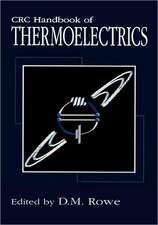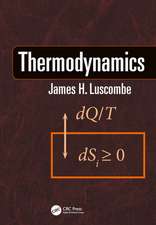Thermodynamics in Materials Science
Autor Robert DeHoffen Limba Engleză Paperback – 13 mar 2006
The up-to-date and complete coverage ofthermodynamic data, laws, definitions, strategies, and tools in Thermodynamics in Materials Science, Second Edition provides students and practicing engineers a valuable guide for producing and applying maps of equilibrium states to everyday applications in materials sciences.
Preț: 940.17 lei
Preț vechi: 1033.16 lei
-9% Nou
Puncte Express: 1410
Preț estimativ în valută:
179.90€ • 187.83$ • 148.89£
179.90€ • 187.83$ • 148.89£
Carte disponibilă
Livrare economică 14-28 martie
Livrare express 27 februarie-05 martie pentru 49.69 lei
Preluare comenzi: 021 569.72.76
Specificații
ISBN-13: 9780849340659
ISBN-10: 0849340659
Pagini: 624
Ilustrații: 150 black & white illustrations
Dimensiuni: 156 x 234 x 33 mm
Greutate: 1 kg
Ediția:2 Rev ed.
Editura: CRC Press
Colecția CRC Press
ISBN-10: 0849340659
Pagini: 624
Ilustrații: 150 black & white illustrations
Dimensiuni: 156 x 234 x 33 mm
Greutate: 1 kg
Ediția:2 Rev ed.
Editura: CRC Press
Colecția CRC Press
Public țintă
UndergraduateCuprins
Introduction. The Structure of Thermodynamics. The Laws of Thermodynamics. Thermodynamic Variables and Relations. Equilibrium in Thermodynamic Systems. Statistical Thermodynamics. Unary Heterogeneous Systems. Multicomponent, Homogenous Non-Reacting Systems: Solutions. Multicomponent Hetergenous Systems. Thermodynamics of Phase Diagrams. Multicomponent, Multiphase Reacting Systems. Capillarity Effects in Thermodynamics. Defects in Crystals. Equilibrium in Continuous Systems: Thermodynamic Effects of External Fields. Electrochemistry.
Descriere
This book explains the thermodynamics background necessary for generating accurate maps of equilibrium states to predict behavior in a wide range of materials. It also illustrates which maps are best suited for specific real-world scenarios and thermodynamic problems. This second edition introduces new, more userfriendly computer software for converting more comprehensive databases into equilibrium maps. Examples and sample problems show how to apply appropriate strategies and develop the working equations of thermodynamics for systems of systematically increasing complexity. A printed solutions manual and online instructor’s notes are available with qualifying course adoption.
























![Molecular Thermodynamics of Electrolyte Solutions [With CDROM]](https://i3.books-express.ro/bt/9789812814180/molecular-thermodynamics-of-electrolyte-solutions-with-cdrom.jpg)